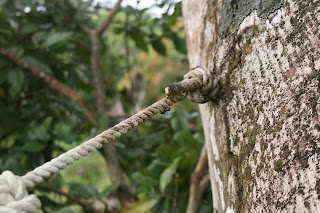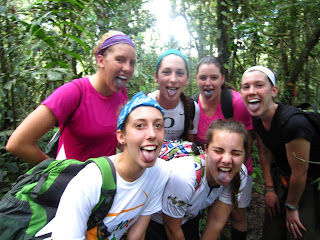I took a four-day trip to
the Tiputini Biodiversity Station in the Amazon Rainforest. The station is run
by the university I am attending here, so all of the international students
have the opportunity to go for a short trip. The station is located on the
Tiputini River, close to Yasuni National Park. To get there we took a 30 minute
flight from Quito to Coca, a 20 minute bus ride to the river, a one and a half
hour boat ride along the Napo river, a two hour bus ride to the Tiputini River,
and finally a two hour boat ride up the Tiputini River. I have never felt so
far away from civilization.
The cabins
When we arrived we walked up
the stairs from the river to the open air dining hall. “Woooow the rumors are
true!” one student said, “there ARE unlimited Oreos here.” Sure enough next to
the table with coffee and tea was a pile of Oreos. Apparently they are the
researcher’s snack of choice. The food there was delicious – soup with yucca,
pasta, beans and rice, and they even had plenty of tofu for the vegetarians.
That night we explored the trails around the station and then split up into
cabins for the night. We also listened to a powerpoint presentation given by
the resident manager about a world wide camera-trap project that they are
participating in. There have set up heat and motion activated hidden cameras
around the rainforest to collect data on animal populations and behavioral
patters. The pictures captured by the cameras are pretty incredible. My
favorite was a series of photos of an armadillo walking past the camera at
night: in the first picture he is walking along, but in the second picture he
is about four feet in the hair, having been surprised by the flash.
The kitchen
The next morning we split up
into groups of six, each with a guide who would take us around the jungle for
the next two days.
Our guide Jose driving the boat.
First Jose took us to the canopy bridges, which are about 40 meters up in the trees. With our harnesses tightly fastened, we walked along the bridges and peered out over the tops of the trees. It was a gorgeous view and I was struck by how expansive and dense the forest looked.
My friend climbing up to the high platform.
Looking down from the high platform.
The view from 40 meters up!
This ant on the rope is called a Bullet Ant. One of them bit the director of international studies and he said that he fell down immediately and felt as though he had been kicked by a horse. For the next 12 hours he was in excruciating pain and had a high fever.
I was amazed by Jose’s knowledge of the jungle. We would be walking and
suddenly stop, having seen or heard an animal that none of us had
noticed, despite our attempts at walking silently. One time he stopped and said,
“do you guys smell that?” He had smelled the recent presence of an animal. I
sniffed and sniffed, but didn’t smell anything of note. Often when we were
walking through the jungle he would stop and point to a plant and say, “do you
guys know what this is?” We never did, and we had to trust him when, with an
amused smile, he would tell us to eat it, smell it, or touch it. He loved to
play little tricks with us, for example:
Once he picked the light green
stem of a plant and told us to chew it for 2 minutes. When we asked him what
would happen he just told us to wait and see. I chewed and chewed, waiting for
the flavorless plant to suddenly produce a strong flavor or change texture in
my mouth. After two minutes when nothing had happened we were slightly
confused. He laughed and told us to look at our tongues. They were blue!
Another time we were floating in a canoe on a lagoon and he stopped the
boat by a tree with a large hive on the trunk. “Ok guys,” he said in Spanish,
“on the count of three you are all going to yell MARCHING (in English) as loud
as you can.” We had always made an effort to be as silent as possible while in
the rainforest in order to see as many animals as possible, so the prospect of
yelling was very exciting. Jose counted to three and we yelled MARCHING and
then were silent, not sure what we were waiting for. After the echo of our
voices dissipated, we heard the sound of many feet marching, exactly how an army
sounds. It was coming from the hive. Jose explaining that the specie of wasps
makes that sound with their wings when they are disturbed by a loud sound.
Below: some of the animals we saw in the lagoon
In the same lagoon, Jose told
us to pick some hard fruits and take then back to shore with us. Once on land
he cut them in half and explained that if we put the clear juice on our skin
and let it dry, within 30 minutes it will turn a bluish black that will last
for eight days (minimum!). So with twigs we smashes up the seeds inside the
fruit and drew tattoos on each other.
My tattoo!
Once when we ran into a line
of army ants crossing the trail, he picked up one of the large ones with
pincers. He told us that the indigenous used the pincers as stitches in order
to close wounds. He demonstrated with a shirt how the ants latch on with their
pincers and get stuck. The indigenous population in the area would then rip off
the body of the ant and leave the head with the pincers in their skin for a few
days until the cut had started to heal.
As we were walking we came
to a clearing where there were only a few trees. “Indigenous populations call
this a devil’s circle” Jose told us, “trees don’t grow here because the devil
has cursed this spot.” Then he laughed a little and explained that the real
reason is because of a certain type of ant that is living here. He pointed to
little bulges in the branches of trees. Inside, he told us, are colonies of
ants that are acidic. They have a symbiotic relationship with one type of tree,
but they kill other trees that try to grow in the same area. He broke off a
branch and cut open one of the colonies. “Lick the ants!” he
told us. They tasted like lemon!
On Saturday night we went on
a night hike to look for nocturnal animals. Although another group saw an
armadillo, we didn’t see any big animals. However, we found LOTS of insects:
On Sunday morning we woke up
at 5:30 am to walk to a canopy tower and see the sunrise. We ate breakfast up
on the platform and watched the jungle wake up:
A granadilla! Part of the delicious breakfast up in the trees.
By the tower there was an old strangle tree that we got to climb inside. Strangle trees wrap themselves around already existing trees, and as our guide explained, "hug them to death." The tree inside this one had died, creating the illusion of a hollow tree.
On Sunday afternoon we went
for a swim in the river and floated down it for almost an hour. Once I got over
my fear of encountering an anaconda or a pack of piranhas, it was quite
relaxing to travel through the jungle and around the bends on the strong current.
The four days in the Amazon
went by much too quickly. It was a completely different world that I would love
to go back to. My favorite part may have been the jungle at night. Lying in bed
I loved falling asleep to the sounds of the jungle. I have grown accustomed to
falling asleep to car alarms and barking dogs in Quito, and the jungle was just
as loud at night, but with sounds of frogs, birds, and insects. I have never
been in a place that was so vibrantly alive.
Above: the Tiputini River
Below: Some other cools things we encountered
A millipede
A leaf frog
A howler monkey
A praying mantis eating a cockroach
This leaf can be used as a nail file!
Some kind of bat
On our trip we were also
confronted by the sad reality that the jungle is not so slowing being
destroyed. On our boat ride on the Napo River we passed by an oil tower. I can
only imaging the pollution and damage it is causing to the surrounding forest
and the river only a few hundred meters away. The Tiputini Biodiversity Station
is located close to Yasuni National park, which is the protected area of the
Amazon in Ecuador. It used to be a large circle on the Eastern border of the
country, but now it is shaped like a backwards "C" as land has been partitioned
for drilling by oil companies. Known as “the lungs of the world,” the health of
the Amazon affects the health of each of us, and I hope that Ecuador and the
other Amazonian countries recognize the importance of protecting this jungle.





































No comments:
Post a Comment